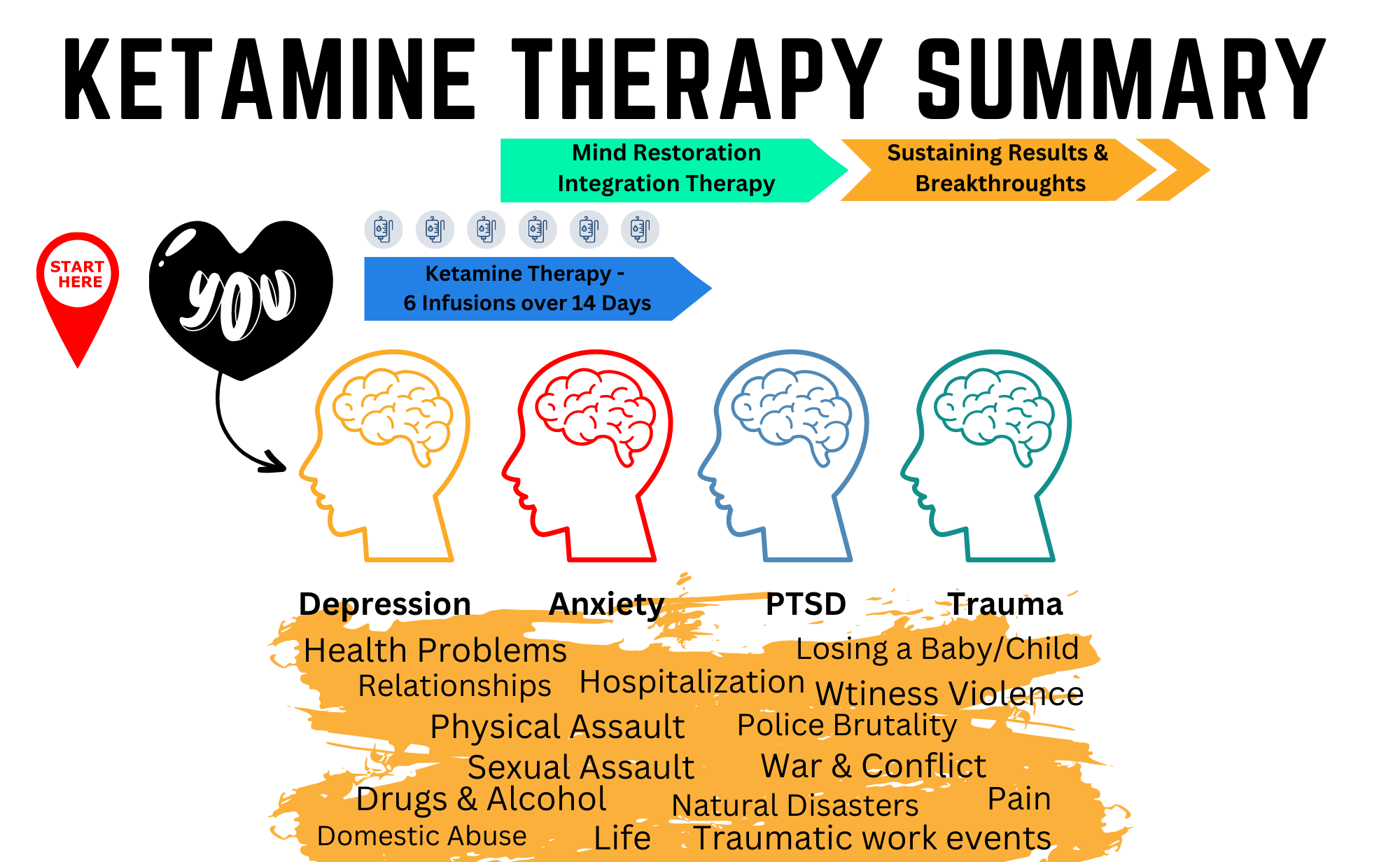
Ketamine Therapy Summary
If you suffer from PTSD, anxiety, stress, trauma, or any combination of these illnesses then you know how hard it can be to find relief. Many individuals lose hope over time, thinking that prescriptions, therapy, and psychiatrists may be the only way to treat an illness that doesn’t seem to lessen its grip on your mind. At Mindful Evolution, we’re happy to share with our clients a fantastic breakthrough in how we treat these illnesses called Ketamine Therapy. This therapy allows individuals suffering with PTSD and associated symptoms to process their trauma in a way that works. Thousands of patients have discovered that with only a few treatments, they are able to reintegrate with their lives, reconnect with their loved ones, and do better in daily interactions at work, home, and in public. Read on to learn more about Ketamine therapy and get all of the answers to your questions.
Ketamine for Pain: What to Know
A person whose name shall remain anonymous was in a car accident that left him paralyzed. He spent approximately 6 months in physical therapy, with very little improvement. Then, under the care of a health professional, he tried Ketamine Therapy. His ketamine treatment started in October 2021 and by February 2022, he was walking again. When we did a follow up appointment with him in February 2023, everything was different about him, and the health professionals at Mindful Evolution found that there is no external evidence that at one time he could not walk.
Ketamine for a Spiritual Journey: What to Know
Christa Coulter-Scott, a pediatric nurse from Athens, GA, got treatment in a similar setting in Gainesville, GA. She says she didn’t want to wake up. “It was like a spiritual journey. I felt warm, safe, and confident. As the treatment went on, all the weight of stress was taken off of me in layers. I felt like I had the power of the universe at my fingertips.”
Yet, after ketamine therapy, she says, “My head feels lighter, and I don’t have that gloomy, dark, heavy feeling in my mind. And everything around me looks brighter — the sun, the lights in my office.” When she returned to work the next day after an infusion, she asked a co-worker whether the lighting had been changed. It hadn’t. “I don’t know if it’s a side effect of ketamine or a side effect of being less depressed.”
Another testimonial from a gentleman named Winograd describes it similarly. He talks about feeling like he was floating in a color. “It was the first time I understood the expression ‘happy place.’ It was this space where everything that had to do with my real life disappeared, and I didn’t have any of that weight that I carry with me everywhere I go.”
Many clients from Mindful Evolution have similar testimonials to provide, but if you have specific questions, we highly encourage you to continue to browse this site for more information or set up a free consultation today to learn more.
Ketamine for Depression and Painful Memories: What to Know
A veteran who wishes to remain anonymous was not in combat but had experienced enough while serving that took him into deep depression and he almost lost everything. He lost his wife and children and eventually became homeless and addicted to drugs. His only hope was to become a participant in a study for Ketamine and after having several ketamine treatments he kicked his addition, his depression, and is a completely new person both inside and out. Currently, he takes great care of this health, is 85 years old and takes no medication.
What Is Ketamine?
Ketamine got its start in Belgium in the 1960s as an anesthesia medicine for animals. The FDA approved it as an anesthetic for people in 1970. It was used in treating injured soldiers on the battlefields during the Vietnam War.
Emergency responders may give it to an agitated patient who, for example, they have rescued from a suicide attempt. That’s how Ken Stewart, MD, says doctors began to realize that the drug had powerful effects against depression and suicidal thoughts. “Someone is trying to jump off a bridge and they give him ketamine in the ambulance to calm him down and 9 months later, he says, ‘I haven’t felt suicidal for 9 months.’
Some doctors also use ketamine to treat suicidal thoughts. Ketamine causes what doctors call a “dissociative experience” and what most anyone else would call a “trip.” That’s how it became a club drug, called K, Special K, Super K, and Vitamin K among others. Partiers inject it, put it in drinks, snort it, or add it to joints or cigarettes. “Ketamine can produce feelings of unreality; visual and sensory distortions; a distorted feeling about one’s body; temporary unusual thoughts and beliefs; and a euphoria or a buzz,” says John Krystal, MD, chief of psychiatry at Yale-New Haven Hospital and Yale School of Medicine in Connecticut, where he is a leader in studying ketamine’s antidepressant effects.
The trip lasts about 2 hours. But without help from a medical professional there can be risks of casual use. If used inappropriately Ketamine can cause unconsciousness, high blood pressure, and dangerously slowed breathing. There are also long-term problems when it is abused, such as ulcers and pain in the bladder; kidney problems; stomach pain; depression; and poor memory. Ketamine could be fatal for people who abuse alcohol or if you take it while you’re drunk.
The drug’s potential as a treatment for depression and antidote to suicidal thoughts has drawn researchers’ attention. They’ve studied and administered it in controlled, clinical settings to help with treatment-resistant depression and other conditions.
To be clear: Casual use is not a treatment for depression. But doctors have developed a protocol for medically supervised use that may help people who don’t get relief from other medications. Patients at Mindful Evolution are finding that with the guidance and assistance of health professionals they are finding relief for their depression, sometimes for the very first time.
Receiving Ketamine
Ketamine comes in several forms. The only one that the FDA has approved as a medication for depression is a nasal spray called Esketamine (Spravato). It’s for adults who either haven’t been helped by antidepressant pills, have major depressive disorder, or are suicidal. They continue on their antidepressant and receive esketamine at a doctor’s office or in a clinic, where a health care provider can watch over them for 2 hours after the dose.
For treatment-resistant depression, patients usually get the nasal spray twice a week for 1 to 4 weeks; then once a week for weeks 5 to 9; and then once every week or 2 after that. The spray has a “black box” warning about the risk of sedation and trouble with attention, judgment, and thinking, as well as risk for abuse or misuse of the drug and suicidal thoughts and behaviors.
Other forms of ketamine which are still being reviewed by the FDA can be used for mental health conditions. These include IV infusion, a shot in the arm, or lozenges. Most research looks at ketamine given by IV. You can only get it by IV or injection here at Mindful Evolution, and our patients are finding it highly effective. We have an integration approach, where the treatments are administered as six infusions over 3 weeks. The IV infusion lasts about 40 minutes. The dissociative experience starts quickly and takes about 15 to 20 minutes to wear off after the drip ends.
Coming Back to Real Life
After the mind-altering part of the ketamine experience is over, a health provider sits and talks with you in a process called integration, and we assist you in receiving therapy elsewhere to continue your journey. Many times, ketamine leads to an unpacking of the baggage that tends to wear us down; and thus, it is important for you to reflect, discuss, and process appropriately.
Weeks, months, or years after your first series of six to eight doses, you may return for a booster. There is no standard recommendation for when or if you will need a booster. For about 30% of people who complete the whole series, that’s it. They never come back. For those who do come back for boosters, we’ve noticed at Mindful Evolution that the boosters get further and further apart until they eventually don’t need them again.
How It Works
When ketamine is in your system, you’ll likely have the dissociative effects, but that’s not the treatment. That’s just something you go through to get the treatment. The ketamine treatment is the reaction of your brain to ketamine, and how your brain responds to exposure to ketamine.
The brain can respond in a few different ways depending on the state it was in to begin with. For example, some people with long-term depression lose some important connections in their brains (called synapses) that let nerve cells communicate. But research shows that within 24 hours of the first dose of medically supervised ketamine, those lost connections start to regrow. The more synapses they grow, the better the antidepressant effects of ketamine are for them. Patients at Mindful Evolution report feeling better within 24 hours after their first treatment.
Other Effects Ketamine May Have on the Brain
Ketamine may work in other ways in the brain, too. Some nerve cells (neurons) in the brain involved in mood use a chemical (neurotransmitter) called glutamate to communicate with each other. The nerve cells need glutamate receptors — think of them like catcher’s mitts for glutamate — to join in this communication.
In the brains of some people with depression, those nerve cells don’t get so excited by glutamate anymore. It’s as if the glutamate receptors — the catcher’s mitts — are deactivated or weakened.
At Mindful Evolution, we’ve found that after people with this problem receive ketamine, those nerve cell connections get restocked with new glutamate receptors. It’s as if ketamine helps make new catcher’s mitts for the glutamate, so that the nerve cells can respond to it again.
Reshaping the Brain
As for the drug’s action on glutamate receptors: Regrowing and reactivating synapses helps the brain’s ability to change, which may help it shift out of depression. That may also explain why antidepressants or psychotherapy that didn’t help before ketamine but may help afterward.
Costs and Insurance
Typically, the only ketamine treatment for depression that insurance will cover is the FDA-approved nasal spray called Esketamine (Spravato). Because the FDA has not approved IV ketamine for depression, most insurance doesn’t cover it.
At Mindful Evolution each infusion costs $450. That comes to about $3,000 to $4,000 out of pocket for six infusions over 3 weeks. This doesn’t include boosters for whenever symptoms reappear. As many of our clients can attest, this is a small price to pay to be able to finally get their lives back on track, and is much less than years of therapy, medications that don’t work, and feeling unstable and unsafe.
What the cost could mean to you and your family?


